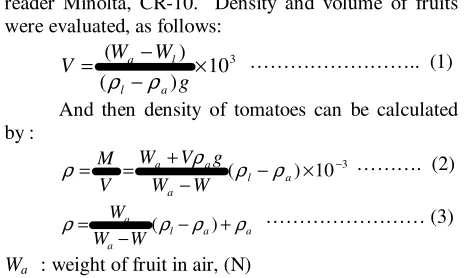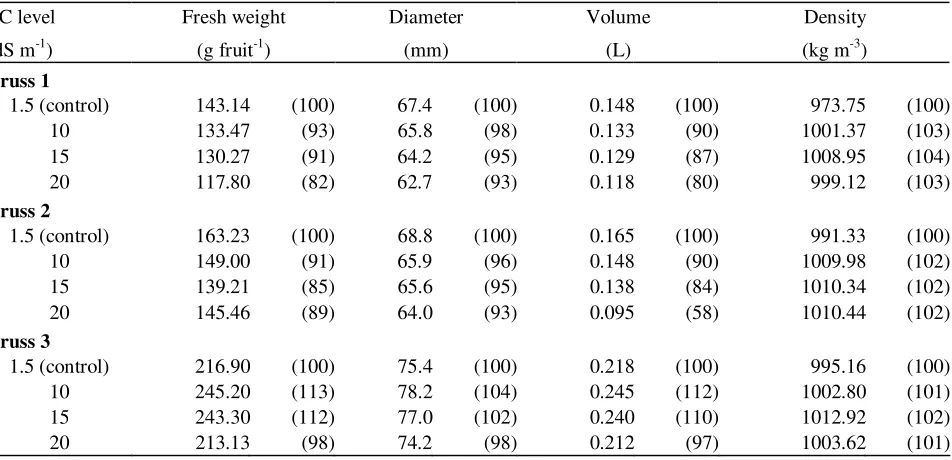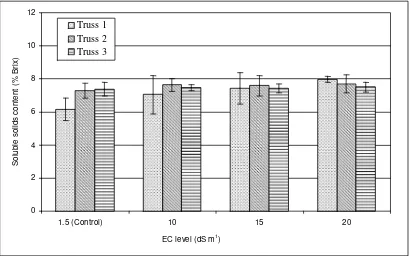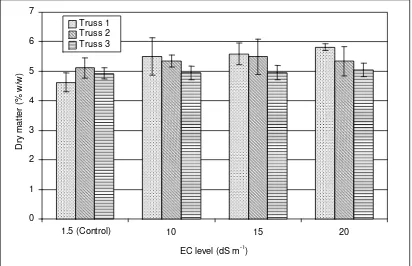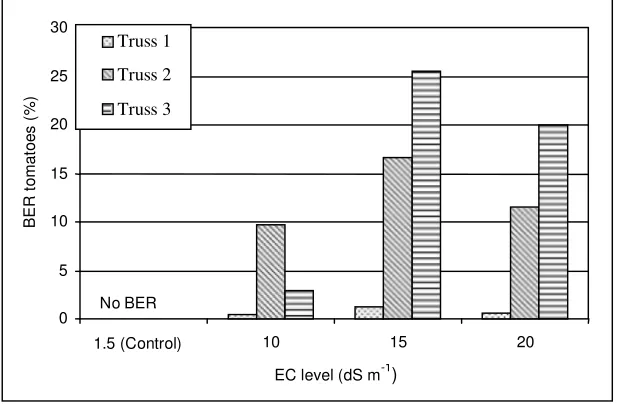1
Department of Agricultural Engineering, Faculty of Agricultural Engineering and Technology, Bogor Agricultural University, PO BOX 220 Bogor 16002, Indonesia (*Author for correspondence)
2 Professor at Department of Biomechanical Systems, Faculty of Agriculture, Kochi University, Nankoku 783, Japan 3
Department of Agronomy and Horticulture, Faculty of Agriculture, Bogor Agricultural University, Indonesia
Application of Deep Sea Water (DSW) for Nutrient Supplement in Hydroponics
Cultivation of Tomato : Effect of supplemented DSW at Different EC Levels on Fruit Properties
Yudi Chadirin1*, Takahisa Matsuoka2, Herry Suhardiyanto1 and Anas D. Susila3 Diterima 1 Mei 2007/Disetujui 26 Juli 2007
ABSTRACT
Deep sea water (DSW) has the potential characteristics for nutrient supplement in hydroponics cultivation. This experiment was carried out to evaluate the application of DSW as a nutrient supplement for tomato cultivation in hydroponics system. Tomatoes were grown on 4 beds in nutrient film technique (NFT) system circulated with 1.5 dS m -1
(control), 10 dS m-1 15 dS m-1 and 20 dS m-1 of nutrient solution, respectively. DSW was supplemented into nutrient solution of control to obtain high EC level. Fresh weight of fruits decreased varied from 10-20% by increasing DSW concentration in nutrient solution, but the effect of the treatment was not found on size of 3rd truss fruits. The density of fruits increased as the DSW concentration increased in nutrient solution. Tomato stiffness of treated plants had almost the same value among EC levels although different among 3 trusses. Fruit quality parameters increased by increasing the DSW concentration in nutrient solution. Treated plants circulated with EC 20 dS m-1 supplemented nutrient solution for 2 weeks produced tomatoes with highest soluble solids, 8.0% Brix or increased 30% of control (1st truss). However there were no significant effect on fruits of 2nd and 3rd trusses. DSW could be used as nutrient supplement for hydroponics cultivation of tomato.
Key words : Deep sea water, fruit quality, electrical conductivity, tomato
INTRODUCTION
Deep sea water (DSW), accounting for 95% of all the sea water, generally refers to sea water from a depth of more than 200 m. DSW has cold temperature, abundant nutrients, and good water quality that is pathogen-free and stable. DSW contains a lot of minerals such as Na+, Mg2+, K+, and Ca2+. When DSW is supplemented into nutrient solution for hydroponics it increases electrical conductivity (EC) of the nutrient solution (Fallah, 2005).
Previous studies have shown that parameters of fruit quality such as soluble solids content, titratable acidity and dry matter increased by increasing EC level of nutrient solution from 2 to 10 dS m-1 (Soria and Cuartero, 1998; Eltez et al., 2002; Ling Li et al., 2001; Okano et al., 2002). However, the higher quality of tomato fruits that was obtained in high EC level of nutrient solution is often adversely affected by the appearance of blossom end rot (BER) and the yield is decreased by 5.1 % per dS m-1 above 2 dS m-1 (Ling Li
et al., 2001). In previous study, salinity was obtained by adding sodium chloride (NaCl), or concentrated nutrition to obtain varied EC level of 2 – 9.5 mS m -1
(Schwarz and Kuchenbuch, 1998; Ling Li et al., 2001;
Eltez et al., 2002; Okano et al., 2002; Katerji et al, 2003). It was reported that under higher EC level of nutrient solution, treated plants produced fruits in smaller size (Eltez et al., 2002; Okano et al., 2002). It was reported that in single-truss tomato cultivation, there was a high rate of occurrence of blossom-end rot when salinity was applied 3 days after pollination (Okano et al., 2002). Therefore, EC of the nutrient solution should be maintained at the right level not only for high quality of tomato fruit but also for preventing BER.
MATERIALS AND METHODS
Cultivation
Tomatoes (Lycopersicon esculentum cv House Momotaro) were sown on rock wool on October 24, 2002. Tomatoes were grown on nutrient film technique (NFT) system starting from December 28, 2002 until May 10, 2003 in greenhouse of Kochi University Japan. The NFT system contained 4 beds in which each bed had length 10 m and slope 1 %. These beds contained 40 plants per bed and nutrient solution was circulated from 100 L tank solution through bed with flow rate 3 L min-1.
Nutrient solution was made based on Otsuka Solution. Control bed was circulated with nutrient solution at electrical conductivity (EC) level of 1.5 dS m-1. Treated beds were circulated with nutrient solution that was made by supplementing DSW into nutrient solution control until reaching designed EC levels. To obtain the effect of EC level on fruit properties, the experiment was set up for 4 beds cultivation with EC 1.5 (control), 10.0, 15.0, 20.0 dS m-1, respectively. This treatment was conducted for 2 weeks. After 2 weeks treatment, all beds were circulated with nutrient solution EC 1.5 dSm-1.
Tomatoes were maintained on 5 fruits per truss and 3 trusses per plant. For analysis of fruit properties, fruit samples were taken from 1st, 2nd, and 3rd truss. Fruits of 1st truss were pollinated on January 20, 2003. Fruits of 2nd truss were pollinated on February 5, 2003 and fruits of 3rd truss were pollinated on February 21, 2003. DSW treatment was started on February 21, 2003 at 06.00 p.m. At that time, 1st truss, 2nd truss and 3rd truss were respectively 30 days, 16 days and 1 day after pollination. After DSW treatment was released, nutrient solution was maintained at 1.5 dS m-1 for all treated beds, same with control.
Analysis of Fruit Properties
Tomatoes were harvested at full ripe stage. Seven tomatoes from each bed and each truss were taken randomly for analysis of fruit properties. Tomatoes were weighed and their color was evaluated by color reader Minolta, CR-10. Density and volume of fruits were evaluated, as follows:
3 10 ) ( ) ( × − − = g W W V a l l a ρ
ρ ……….. (1)
And then density of tomatoes can be calculated by : 3 10 ) ( − × − − + =
= l a
a a a W W g V W V
M ρ ρ ρ
ρ ………. (2)
a a l a W W
W ρ ρ ρ
ρ − +
−
= ( ) ……… (3)
Wl : weight of fruit in liquid, (N)
M : mass of fruit, (kg)
g : gravitation, (m s-2)
V : volume of fruit, ( L)
ρ : density of tomato, (kg m-3)
ρa : density of air, (kg m-3)
ρl : density of liquid, (kg m-3)
After density of fruits was evaluated, stiffness of tomato was measured using rheometer, “Shimadzu EZtest”. For measuring the stiffness of tomato its force-displacement curve was obtained by conducting compression test using rheometer. The fruits were positioned with their stem horizontal and the load was applied perpendicular to fruit using a 3 mm cylindrical stainless steel probe with a flat end and the test speed was 2 mm min-1. The force-displacement test was performed until 2 mm displacement. The rheometer “Shimadzu EZtest” was connected into personal computer for recording and displaying the results. Stiffness or rigidity is indicated by the slope of straight line portion of the force-displacement curve. An initial tangent was drawn to this curve at 0.5-1.5 mm displacement. At this interval, curve was being straight. Slope was measured as surface stiffness. Stiffness value was obtained by averaging data from 4 positions of measurement.
Tomato sample was divided into 4 pieces by slicing vertically and horizontally. Two pieces were juiced using hand mixer and then filtered using filter paper meanwhile the other pieces were evaluated for dry matter. This puree was measured for soluble solids content and acidity. Soluble solids content of tomato was measured in term % of Bricks by using digital refractometer (Atago, model PR-101, Japan). Acidity (% w/v) was measured by an acid meter (Sourty, Model Sou-1, Shimadzu, Japan) supplied with a standard reagent. Another two pieces of the tomato sample were dried by using oven at 70 oC temperature until the weight is constant.
RESULTS AND DISCUSSION Results
Environmental Condition
[image:2.612.63.295.695.834.2]Concentration of DSW in nutrient solution influenced the EC level of nutrient solution, that is higher DSW concentration resulted in higher EC level
of nutrient solution. Water uptake decreased by increasing EC level of nutrient solution.
[Figure 1. Time course of electrical conductivity of nutrient solution]
Fruit Properties
High EC level of nutrient solution caused a decrease in fruit size. For 1st truss, average fruit size from bed with EC level of 1.5 (control), 10.0, 15.0 and 20.0 dS m-1 were 67.4, 65.8, 64.2 and 62.7 mm, respectively. When the size of treated tomatoes was compared to the control tomatoes, the highest decrement was obtained from bed with highest EC level 20.0 dS m -1
. It was 7% for 1st truss fruits. For the 2nd truss, fruits size were 68.8, 65.9, 65.6 and 64.0 mm, respectively. Third truss produced bigger tomatoes than fruits of 1st and 2nd truss for both treated and control beds as the effect of stopping DSW treatment. (Table 1).
DSW treatment affected final size of harvested tomatoes. Average of fresh weight was decreased by duration of treatment for 1st, 2nd and 3rd truss (Table 1). Fresh weight of 1st truss fruits were 143.14, 133.47, 130.27, 117.80 g fruit-1, respectively from control to 20
mS m-1 of EC treatment. In the same plants, fresh weight increased from 1st truss to 3rd truss.
Both treated and control plants produced tomatoes with volume below 0.200 L for 1st and 2nd truss and above 0.200 L for 3rd truss (Table 1). The smallest volume was obtained from bed with the highest EC level of nutrient solution (20.0 dS m-1). For 1st truss, the fruit volume was 0.118 L, while the control tomatoes were 0.148 L. These values imply that the EC level of 20.0 dS m-1 decreased fruit volume 20%. The effect of high EC level was not found on fruit volume for 3rd truss (only 1 day influerence .
Inversely with effect of high EC level on the fruit volume, density of fruit increased by EC level. Control tomatoes had density below 1000.00 kg m-3 while treated tomatoes had density above 1000.00 kg m-3 (Table 1).
0 5 10 15 20 25 30
2/20 2/27 3/6 3/13 3/20 3/27 4/3 4/10
Date
EC
(
d
S
m
-1 )
EC 10 dS m-1
EC 15 10 dS m-1 EC 20 10 dS m-1
Solution is changed (control bed)
Solution is changed (treatment bed) Control
EC 10 dS m-1
EC 15 dS m-1 EC 20 dS m-1
Solution changed (control bed) Solution changed (treatment beds) Treatment started
Table 1. The effect of DSW concentration in nutrient solution on fruit properties of tomato.
EC level Fresh weight Diameter Volume Density
(dS m-1) (g fruit-1) (mm) (L) (kg m-3)
Truss 1
1.5 (control) 143.14 (100) 67.4 (100) 0.148 (100) 973.75 (100)
10 133.47 (93) 65.8 (98) 0.133 (90) 1001.37 (103)
15 130.27 (91) 64.2 (95) 0.129 (87) 1008.95 (104)
20 117.80 (82) 62.7 (93) 0.118 (80) 999.12 (103)
Truss 2
1.5 (control) 163.23 (100) 68.8 (100) 0.165 (100) 991.33 (100)
10 149.00 (91) 65.9 (96) 0.148 (90) 1009.98 (102)
15 139.21 (85) 65.6 (95) 0.138 (84) 1010.34 (102)
20 145.46 (89) 64.0 (93) 0.095 (58) 1010.44 (102)
Truss 3
1.5 (control) 216.90 (100) 75.4 (100) 0.218 (100) 995.16 (100)
10 245.20 (113) 78.2 (104) 0.245 (112) 1002.80 (101)
15 243.30 (112) 77.0 (102) 0.240 (110) 1012.92 (102)
20 213.13 (98) 74.2 (98) 0.212 (97) 1003.62 (101)
Values are mean of seven samples
Number in parantheses is relative values from control
In contrast with fresh weight per fruit which increased from 1st truss to 3rd truss, stiffness of whole fruit decreased from 1st truss to 3rd truss. The highest fruit stiffness was 4.06 N mm-1 that was obtained from 1st truss with EC level of nutrient solution of 20.0 dS m -1
and the lowest was 2.03 N mm-1, that was obtained from 3rd truss with EC of 10.0 dS m-1 (Figure 2).
Increasing EC level of nutrient solution had increased the parameter of fruit quality such as soluble solids content, acidity and flavor of tomatoes fruit. Treated plants produced tomatoes with higher soluble solids content than that of control tomatoes (Figure 3). The highest soluble solids content was 8.0 % Brix that was showed by 1st truss fruits with highest EC level of nutrient solution of 20.0 dS m-1. The lowest soluble solids content was 6.7 % Brix. It was obtained from 1st truss fruit of control bed. This value meant that nutrient solution with 20.0 dS m-1 EC could increase soluble solids content of treated tomatoes by 30 % than that of control tomatoes in winter cultivation. This increment tended to decline from 1st truss to 3rd truss.
Treated tomatoes had acidity slightly higher than that of control tomatoes. The highest acidity was 0.44 % w/v that was obtained from 1st truss fruits with EC level of 10.0 dS m-1 while acidity of control tomatoes was 0.37 % w/v. It means increasing EC level of nutrient solution increased acidity of fruits by 17 %. In the same beds, acidity of tomato fruits tends to descend from 1st truss to 3rd truss (Figure 4).
Figure 2. The effect of DSW application to the nutrient solution on the stiffness of tomato fruits
Figure 3. The effect of DSW application to the nutrient solution on the soluble solids content of tomato fruits 0.00
1.00 2.00 3.00 4.00 5.00
10 15 20
EC level (dS m1)
Sti
ff
ne
s
s (N
mm
1
Truss 1 Truss 2 Truss 3
1.5 (Control)
0 2 4 6 8 10 12
1.5 10 15 20
EC level (dS m1)
Solub
le
s
ol
ids co
nt
e
nt
(%
Brix)
Truss 1 Truss 2 Truss 3
[image:5.612.102.512.505.761.2]Figure 4. The effect of DSW application to the nutrient solution on the acidity of tomato fruits
Figure 5. The effect of DSW application to the nutrient solution on the dry matter of tomato fruits
0.0 0.1 0.2 0.3 0.4 0.5 0.6
10 15 20
EC level (dS m-1)
Aci
di
ty (%
w/
v)
Truss 1 Truss 2 Truss 3
1.5 (Control)
0 1 2 3 4 5 6 7
10 15 20
EC level (dS m-1)
Dry
ma
tter
(% w
/w)
Truss 1 Truss 2 Truss 3
[image:6.612.101.513.508.774.2]Yieldsand Physical Disorder
For 1st and 2nd truss, fruit yield decreased because of a reduction in fruit size. Figure 6 shows that the highest production of tomatoes was obtained from the
[image:7.612.147.470.251.468.2]EC of 10.0 dS m-1 and the lowest production was from EC of 20.0 dS m-1. EC level of 10.0 dS m-1 produced the highest fruit number thus increased the fruit yield.
Figure 6. Effect of DSW application to the nutrient solution on the yield per bed
Physiological disorders like fruit cracking and BER were found. Generally, the number of BER fruits increased with the EC level of nutrient solution. Figure 7 shows that BER fruit was not found in control plants but the percentage increased from EC 10.0 dS m-1 to 15.0 dS m-1 and then afterward decreased in 20.0 dS m-1. The highest percentage of BER was obtained from 15.0 dS m-1 EC level, that was 1%, 17% and 26%,
respectively for 1st, 2nd, and 3rd truss. In the same bed, percentage of BER fruits tended to increase from 1st truss to the 3rd truss.
Fruit cracking occurred in both treated and control tomatoes. The percentage of cracking tomatoes were respectively 7%, 21%, 23% and 18% of the beds successively with EC of 1.5 (control), 10.0, 15.0, 20.0 dS m-1.
Figure 7. Effect of DSW application to the nutrient solution on BER occurrences 0
20 40 60 80 100
1.5 (Control) 10 15 20
EC level (dS m-1)
Yields (kg)
Truss 1 Truss 2 Truss 3
0 5 10 15 20 25 30
1.5 10 15 20
EC level (dS m-1)
BER t
omat
oe
s
(
%)
Truss 1
Truss 2
Truss 3
[image:7.612.152.462.610.812.2]Discussion
During DSW treatment in this experiment, fruits of 1st truss (28 days after pollination) and 2nd truss (16 days after pollination) were in period of rapid fruit expansion, meanwhile fruits 3rd truss (0 days after pollination) were in early growth stage. Because of the differences in growth stage, fruit size, fresh weight per fruit and volume of tomatoes decreased according to EC level of nutrient solution. Stronger effect was found on fruits which were in a period of rapid expansion than that in the early growth stage. Under high EC level, crop performance might be adversely affected by water deficit arising from the low water potential of nutrient solution (known as osmotic effect). Increasing EC level of nutrient solution decreases water availability and water uptake and thus reduces root pressure-driven xylem transport of water and water solute. Thus, it limits the cell expansion of plant cell. This phenomenon was suggested to be caused of the decreasing fruits size, fresh weight per fruit, volume of fruit but increased density of fruit (Ling Li et al., 2001; Katerji et al., 2003).
In this experiment, both treated and control plants produced tomatoes that tend to increase in size of fruit for 3rd truss. Increase in size of fruit caused increasing of fresh weight and volume per fruit. Fruits became bigger because water flow into the fruits increased after DSW treatment was stopped. Fruits of 3rd truss grew normally like the control tomatoes, while stiffness of whole fruit decreased from 1st truss to 3rd truss.
The highest increment of fruit quality parameters was obtained from fruits of 1st truss. This increment tended to decline from 1st truss to 3rd truss. It is supposed that the effect of treatment is stopped because 3rd truss fruits are in the earliest growth stage. These results are un coincidence with that reported by Eltez et al. (2002) who noted that parameters of fruit quality, such as soluble solids content and acidity, increased by increasing EC level of nutrient solution.
Quality of tomato obtained in high EC level of nutrient solution is often adversely affected by the appearance of BER. BER symptom begins as a slight browning at distal placental tissue which progressively invades the pericarp; beside the necrosis of the affected tissue, the fruits stop growing and start ripening too early. BER are caused by a local Ca2+ deficiency at the distal placental fruit tissue (Cuartero and Munoz, 1999). Supplementation of DSW increased the salinity of nutrient solution, subsequently reduced the Ca2+ uptake thus fruit contains less Ca2+. In winter, air humidity is low that cause an increase in transpiration. As a consequence, more Ca2+ moved to leaves and less to the fruit, causing the BER in tomato plants occurred.
The yields reduction was mainly due the smaller
st nd rd
by BER even though the fruits were bigger than fruits of 1st and 2nd truss. The EC level of 10.0 dS m-1 had the highest yields due the higher fruits harvested.
Nowadays many farmers are growing tomato fruits in hydroponics cultivation in Indonesia. As islands country, Indonesia has great potential sea water to apply for cultivation to gain various advantages such cultivation under saline condition. However, the climate condition that characterized by hot and humid should be considered. Under high solar radiation, the saline condition will be affected on plant growth and fruit properties greater than low solar radiation.
CONCLUSIONS
It was concluded that increasing EC level by supplemented DSW into nutrient solution for two weeks, decreased the tomato yields but could improve the taste and quality of fruits by increasing soluble solids content 21 %, acidity 16 %, and dry matter content of tomatoes 21 % respectively. However, the increment of soluble solids content acidity and dry matter of tomatoes tend to decline from 1st truss to 3rd truss. Thus, it is necessary to investigate the duration of treatment to maintain the increment of tomatoes quality in all trusses.
REFERENCES
Bertin, N., N. Guichard, C. Leonardi, J.J. Longuenesse, D. Langlois, N. Naves, 2000. Seasonal evolution of the quality of fresh glasshouse tomatoes under Mediterranean condition, as affected by air vapour pressure deficit and plant fruit load. Annals of Botany 85: 741-750.
Cuartero, J., J.F. Munoz. 1999. Tomato and salinity. Scientia Horticulturae 78: 83-125.
Eltez, R.Z., Y. Tuzel, A. Gul, I.H. Tuzel, H. Duyar. 2002. Effect of different EC levels of nutrient solution on greenhouse tomato growing. International Symposium on Salination for Horticulture Production. Acta Horticulturae 573: 443-448.
Fallah, M.A.F., M. Kitano, D. Yasutake, T. Wajima, T. Yasunaga. 2005. Study on root absorption responding to environmental stress by using hydroponic systems. Phyton (Austria) Special issue : “APGC 2004” Vol 45 (4): 223-228.
single-truss tomato plants. Environment Control in Biology 37 (2): 15-158.
Katerji, N., J.W. van Hoorn, A. Hamdy, M. Mastrorilli. 2003. Salinity effect on crop development and yield, analysis of salt tolerance according to several classification methods. Agricultural Water Management 62: 37-66.
Ling Li, Y. S., C. Stanghellini, Hugo Challa. 2001. Effect of electrical conductivity and transpiration on production of greenhouse tomato (Lycopersicon esculentum L.). Scientia Horticulturae 88: 11-29.
Okano, K., Y. Nakano, S. Watanabe, T. Ikeda. 2002. Control of fruit quality by salinity stress at various fruit development stages of single-truss tomato grown in hydroponics (Japanese text with English abstract). Environment Control in Biology 40: 375-382.
R. Romeo-Aranda, T. Soria. J. Cuartero. 2001. Tomato plant-water uptake and plant-water relationships
under saline growth conditions. Plant Science 160: 265-272.
Schwarz, D., R. Kuchenbuch. 1998. Water uptake by tomato plants grown in closed hydroponic system dependent on the EC-Level. International Symposium on Water Quality & Quantity in Greenhouse Horticulture. Acta Horticulturae 458: 323-328.
Soria, T., J. Cuartero. 1998. Tomato fruit yield and water consumption with salty water irrigation. International Symposium on Water Quality & Quantity in Greenhouse Horticulture. Acta Horticulturae 458: 215-219.
1
Department of Agricultural Engineering, Faculty of Agricultural Engineering and Technology, Bogor Agricultural University, PO BOX 220 Application of Deep Sea Water (DSW) for Nutrient Supplement in Hydroponics
Cultivation of Tomato : Effect of supplemented DSW at Different EC Levels on Fruit Properties
Yudi Chadirin1*, Takahisa Matsuoka2, Herry Suhardiyanto1 and Anas D. Susila3 Diterima 1 Mei 2007/Disetujui 26 Juli 2007
ABSTRACT
Deep sea water (DSW) has the potential characteristics for nutrient supplement in hydroponics cultivation. This experiment was carried out to evaluate the application of DSW as a nutrient supplement for tomato cultivation in hydroponics system. Tomatoes were grown on 4 beds in nutrient film technique (NFT) system circulated with 1.5 dS m -1
(control), 10 dS m-1 15 dS m-1 and 20 dS m-1 of nutrient solution, respectively. DSW was supplemented into nutrient solution of control to obtain high EC level. Fresh weight of fruits decreased varied from 10-20% by increasing DSW concentration in nutrient solution, but the effect of the treatment was not found on size of 3rd truss fruits. The density of fruits increased as the DSW concentration increased in nutrient solution. Tomato stiffness of treated plants had almost the same value among EC levels although different among 3 trusses. Fruit quality parameters increased by increasing the DSW concentration in nutrient solution. Treated plants circulated with EC 20 dS m-1 supplemented nutrient solution for 2 weeks produced tomatoes with highest soluble solids, 8.0% Brix or increased 30% of control (1st truss). However there were no significant effect on fruits of 2nd and 3rd trusses. DSW could be used as nutrient supplement for hydroponics cultivation of tomato.
Key words : Deep sea water, fruit quality, electrical conductivity, tomato
INTRODUCTION
Deep sea water (DSW), accounting for 95% of all the sea water, generally refers to sea water from a depth of more than 200 m. DSW has cold temperature, abundant nutrients, and good water quality that is pathogen-free and stable. DSW contains a lot of minerals such as Na+, Mg2+, K+, and Ca2+. When DSW is supplemented into nutrient solution for hydroponics it increases electrical conductivity (EC) of the nutrient solution (Fallah, 2005).
Previous studies have shown that parameters of fruit quality such as soluble solids content, titratable acidity and dry matter increased by increasing EC level of nutrient solution from 2 to 10 dS m-1 (Soria and Cuartero, 1998; Eltez et al., 2002; Ling Li et al., 2001; Okano et al., 2002). However, the higher quality of tomato fruits that was obtained in high EC level of nutrient solution is often adversely affected by the appearance of blossom end rot (BER) and the yield is decreased by 5.1 % per dS m-1 above 2 dS m-1 (Ling Li
et al., 2001). In previous study, salinity was obtained by adding sodium chloride (NaCl), or concentrated nutrition to obtain varied EC level of 2 – 9.5 mS m -1
(Schwarz and Kuchenbuch, 1998; Ling Li et al., 2001;
Eltez et al., 2002; Okano et al., 2002; Katerji et al, 2003). It was reported that under higher EC level of nutrient solution, treated plants produced fruits in smaller size (Eltez et al., 2002; Okano et al., 2002). It was reported that in single-truss tomato cultivation, there was a high rate of occurrence of blossom-end rot when salinity was applied 3 days after pollination (Okano et al., 2002). Therefore, EC of the nutrient solution should be maintained at the right level not only for high quality of tomato fruit but also for preventing BER.
